A Framework for Assessing Trade-Offs and Synergies in Green Space System Services Based on Ecosystem Services Bundles
Abstract
1. Introduction
2. Research Area and Data
2.1. Research Area
2.2. Research Data Sources
| Category | Index | Abbreviation | Formula | Unit | Reference |
|---|---|---|---|---|---|
| Landscape pattern index | Total area | TA | TA = A/NP | Km2 | [31] |
| Number of patches | NP | The number of patches | Number | [26,32] | |
| Landscape Shape Index | LSI | LSI = 4 π patch area/square of patch circumference | - | [32,33] | |
| CONTAG | CONTAG | CONTAG = SUM ((pi pj dij)/(pi + pj − pi pj)) | % | [34,35] | |
| Interspersion juxtaposition index | IJI | IJI = SUM [(a × dij)/(1 + b × dij)] | % | [33] | |
| Shannon’s diversity index | SHDI | - | [26,28] | ||
| Shannon’s evenness index | SHEI | [0, 1] | [28,32,36] | ||
| Aggregation index | AI | - | [33,34] | ||
| Ecological effect index | Normalized differential vegetation index | NDVI | NDVI = (ρNIR – ρred)/(ρNIR + ρred) | [−1, 1] | [37,38] |
| Land surface temperature | LST | L6 = gain × ND + bias T = K2/ln(K1/L6 + 1) LST = T/[1 + (λT/ρ) lnε] | Degree | [30,39] | |
| Wetness index | WET | Wet = 0.0315ρblue + 0.2021ρgreen + 0.3102ρred + 0.1594ρNIR − 0.6806ρSWIR1 − 0.6109ρSWIR2 | - | [39,40] | |
| Normalized differential build-up and bare soil index | (NDBSI) | NDBSI = (SI + IBI)/2 SI = [(ρSWIR1 + ρred) − (ρblue + ρNIR)]/[(ρSWIR1 + ρred) + (ρblue + ρNIR)] IBI = [2ρSWIR1/(ρSWIR1 + ρNIR) − (ρNIR/(ρNIR + ρred) − ρgreen/(ρgreen + ρSWIR1)]/[2ρSWIR1/(ρSWIR1 + ρNIR) + ρNIR/(ρNIR + ρred) + ρgreen/(ρgreen + ρSWIR1)] | [−1, 1] | [41] | |
| Social effect index | Population density of service area | POD | Permanent population density | Number/km2 | [42,43] |
| Bus station density | BD | Bus station density = number of bus stations/half hour reachable area | Number/km2 | [44] | |
| Parking density | PAD | Parking lot density = number of parking lots/half hour reachable area | Number/km2 | [44,45] | |
| Shopping density | SD | Shopping density/half hour reachable area | Number/km2 | [46] | |
| Restaurant density | RD | Restaurant density = number of restaurants/half hour reachable area | Number/km2 | [47] | |
| Leisure and entertainment density | LD | Leisure and entertainment density = quantity of leisure and entertainment/area reachable in half an hour | Number/km2 | [47] | |
| Tourism accommodation density | TD | Tourism accommodation density = number of tourism accommodations/half hour reachable area | Number/km2 | [48] | |
| Reachable area in half an hour | RA | The range that the public can reach by walking for half an hour based on the density of the road network | Km2 | [43,46] | |
| Spatial effect index | Border frontage rate | BFR | Boundary frontage ratio = boundary frontage length/patch perimeter | % | [25] |
| Green barrier rate | GBR | Green barrier rate = transparent green wall length/patch perimeter | % | [49,50] | |
| Blocking wall rate | BWR | Blocking wall rate = sealing wall length/patch perimeter | % | [49] | |
| Boundary waterfront rate | BR | Boundary waterfront rate = boundary waterfront length/patch perimeter | % | [45] | |
| Boundary openness rate | BOR | Boundary openness = entrance length/patch perimeter | % | [25] |
3. Methods
3.1. Study Design and Setting
3.2. Principal Component Analysis
3.3. Self-Organizing Maps
3.4. Geographically Weighted Regression
4. Result
4.1. Service Characteristics of the Four Systems
4.2. Dimensionality Reduction Analysis
4.3. Analysis of the Major Bundles in the LESS System Services
4.4. Trade-Offs and Synergies among Four Systems
5. Discussion
5.1. Classification of Ring Parks Based on Circle Layer
5.2. The Value Realization Mechanism of the LESS System
5.3. Targeted Planning and Management of Dominated Bundles
5.4. Limitation and Future Research
6. Conclusions
Author Contributions
Funding
Data Availability Statement
Conflicts of Interest
References
- Brander, L.M.; Koetse, M.J. The value of urban open space: Meta-analyses of contingent valuation and hedonic pricing results. J. Environ. Manag. 2011, 92, 2763–2773. [Google Scholar] [CrossRef]
- Niemelä, J. Ecology and urban planning Biodiversity and Conservation. Biodivers. Conserv. 1999, 8, 119–131. [Google Scholar] [CrossRef]
- Gulsrud, N.M.; Hertzog, K.; Shears, I. Innovative urban forestry governance in Melbourne? Investigating “green placemaking” as a nature-based solution. Environ. Res. 2018, 161, 158–167. [Google Scholar] [CrossRef]
- Kong, F.; Yin, H.; Nakagoshi, N.; Zong, Y. Urban green space network development for biodiversity conservation: Identification based on graph theory and gravity modeling. Landsc. Urban Plan. 2010, 95, 16–27. [Google Scholar] [CrossRef]
- Subiza-Pérez, M.; Hauru, K.; Korpela, K.; Haapala, A.; Lehvävirta, S. Perceived Environmental Aesthetic Qualities Scale (PEAQS)—A self-report tool for the evaluation of green-blue spaces. Urban. For. Urban Green. 2019, 43, 126383. [Google Scholar] [CrossRef]
- Cohen-Shacham, E.; Walters, G.; Janzen, C.; Maginnis, S.; Adolphe, L. Nature-Based Solutions to Address Global Societal Challenges; IUCN (International Union for Conservation of Nature): Gland, Switzerland, 2016. [Google Scholar]
- Ives, C.D.; Lentini, P.E.; Threlfall, C.G.; Ikin, K.; Shanahan, D.F.; Garrard, G.E.; Bekessy, S.A.; Fuller, R.A.; Mumaw, L.; Rayner, L.; et al. Cities are hotspots for threatened species. Glob. Ecol. Biogeogr. 2016, 25, 117–126. [Google Scholar] [CrossRef]
- Secretariat of the Convention on Biological Diversity. Cities and Biodiversity Outlook: Action and Policy. Available online: https://www.cbd.int/doc/health/cbo-action-policy-en.pdf (accessed on 20 September 2022).
- Transforming Our World: The 2030 Agenda for Sustainable Development. Available online: https://sustainabledevelopment.un.org (accessed on 20 September 2022).
- Anguluri, R.; Narayanan, P. Role of green space in urban planning: Outlook towards smart cities. Urban. For. Urban Green. 2017, 25, 58–65. [Google Scholar] [CrossRef]
- Maas, J.; van Dillen, S.M.E.; Verheij, R.A.; Groenewegen, P.P. Social contacts as a possible mechanism behind the relation between green space and health. Health Place 2009, 15, 586–595. [Google Scholar] [CrossRef]
- Frantzeskaki, N.; McPhearson, T.; Kabisch, N. Urban sustainability science: Prospects for innovations through a system’s perspective, relational and transformations’ approaches. Ambio 2021, 50, 1650–1658. [Google Scholar] [CrossRef]
- Banzhaf, E.; Kabisch, S.; Knapp, S.; Rink, D.; Wolff, M.; Kindler, A. Integrated research on land-use changes in the face of urban transformations—An analytic framework for further studies. Land Use Policy 2017, 60, 403–407. [Google Scholar] [CrossRef]
- Enqvist, J.P.; Tengö, M.; Bodin, Ö. Are bottom-up approaches good for promoting social–ecological fit in urban landscapes? Ambio 2020, 49, 49–61. [Google Scholar] [CrossRef] [PubMed]
- Murtagh, F.; Contreras, P. Algorithms for hierarchical clustering: An overview. WIREs Data Min. Knowl. Discov. 2011, 2, 86–97. [Google Scholar] [CrossRef]
- Levers, C.; Müller, D.; Erb, K.; Haberl, H.; Jepsen, M.R.; Metzger, M.J.; Meyfroidt, P.; Plieninger, T.; Plutzar, C.; Stürck, J.; et al. Archetypical patterns and trajectories of land systems in Europe. Reg. Environ. Chang. 2018, 18, 715–732. [Google Scholar] [CrossRef]
- Li, S.; Zhao, Y.; Xiao, W.; Yellishetty, M.; Yang, D. Identifying ecosystem service bundles and the spatiotemporal characteristics of trade-offs and synergies in coal mining areas with a high groundwater table. Sci. Total Environ. 2022, 807, 151036. [Google Scholar] [CrossRef]
- Amaral, M.H.; Benites-Lazaro, L.L.; Antonio De Almeida Sinisgalli, P.; Prates Da Fonseca Alves, H.; Giatti, L.L. Environmental injustices on green and blue infrastructure: Urban nexus in a macrometropolitan territory. J. Clean. Prod. 2021, 289, 125829. [Google Scholar] [CrossRef]
- Brunsdon, C.; Fotheringham, A.S.; Charlton, M.E. Geographically weighted regression: A method for exploring spatial nonstationarity. Geogr. Anal. 1996, 28, 281–298. [Google Scholar] [CrossRef]
- McMillen, D. Geographically weighted regression: The analysis of spatially varying relationships. Am. J. Agric. Econ. 2004, 86, 554–556. [Google Scholar] [CrossRef]
- Ma, X.; Ji, Y.; Yuan, Y.; Van Oort, N.; Jin, Y.; Hoogendoorn, S. A comparison in travel patterns and determinants of user demand between docked and dockless bike-sharing systems using multi-sourced data. Transp. Res. Part A Policy Pract. 2020, 139, 148–173. [Google Scholar] [CrossRef]
- Standish, R.J.; Hobbs, R.J.; Miller, J.R. Improving city life: Options for ecological restoration in urban landscapes and how these might influence interactions between people and nature. Landsc. Ecol. 2013, 28, 1213–1221. [Google Scholar] [CrossRef]
- Carpenter, S.R.; Mooney, H.A.; Agard, J.; Capistrano, D.; Defries, R.S.; Diaz, S.; Dietz, T.; Duraiappah, A.K.; Oteng-Yeboah, A.; Pereira, H.M.; et al. Science for managing ecosystem services: Beyond the Millennium Ecosystem Assessment. Proc. Natl. Acad. Sci. USA 2009, 106, 1305–1312. [Google Scholar] [CrossRef]
- Masterson, V.A.; Enqvist, J.P.; Stedman, R.C.; Tengö, M. Sense of place in social–ecological systems: From theory to empirics. Sustain. Sci. 2019, 14, 555–564. [Google Scholar] [CrossRef]
- Rakowska, S.B.; Lutz, K.L.; Réquia, W.J.; Adams, M.D. Examining the effects of green space accessibility on school performance for 3421 elementary schools. Landsc. Urban Plan. 2023, 234, 104731. [Google Scholar] [CrossRef]
- Dramstad, W.E.; Tveit, M.S.; Fjellstad, W.J.; Fry, G.L.A. Relationships between visual landscape preferences and map-based indicators of landscape structure. Landsc. Urban Plan. 2006, 78, 465–474. [Google Scholar] [CrossRef]
- University of Massachusetts-Produced Program. FRAGSTATS: Spatial Pattern Analysis Program for Categorical Maps. Available online: http://www.umass.edu/landeco/research/fragstats/fragstats.html (accessed on 20 September 2022).
- Herbst, H.; Förster, M.; Kleinschmit, B. Contribution of landscape metrics to the assessment of scenic quality—The example of the landscape structure plan Havelland/Germany. Landsc. Online 2009, 10, 1–17. [Google Scholar] [CrossRef]
- Xu, H.; Wang, M.; Shi, T.; Guan, H.; Fang, C.; Lin, Z. Prediction of ecological effects of potential population and impervious surface increases using a remote sensing based ecological index (RSEI). Ecol. Indic. 2018, 93, 730–740. [Google Scholar] [CrossRef]
- Ahmed, K.S. Comfort in urban spaces: Defining the boundaries of outdoor thermal comfort for the tropical urban environments. Energy Build. 2003, 35, 103–110. [Google Scholar] [CrossRef]
- Cohen, D.A.; Marsh, T.; Williamson, S.; Derose, K.P.; Martinez, H.; Setodji, C.; McKenzie, T.L. Parks and physical activity: Why are some parks used more than others? Prev. Med. 2010, 50, S9–S12. [Google Scholar] [CrossRef]
- Dadashpoor, H.; Azizi, P.; Moghadasi, M. Land use change, urbanization, and change in landscape pattern in a metropolitan area. Sci. Total Environ. 2019, 655, 707–719. [Google Scholar] [CrossRef]
- Fan, C.; Myint, S. A comparison of spatial autocorrelation indices and landscape metrics in measuring urban landscape fragmentation. Landsc. Urban Plan. 2014, 121, 117–128. [Google Scholar] [CrossRef]
- Masoudi, M.; Tan, P.Y. Multi-year comparison of the effects of spatial pattern of urban green spaces on urban land surface temperature. Landsc. Urban Plan. 2019, 184, 44–58. [Google Scholar] [CrossRef]
- Ha, J.; Kim, H.J.; With, K.A. Urban green space alone is not enough: A landscape analysis linking the spatial distribution of urban green space to mental health in the city of Chicago. Landsc. Urban Plan. 2022, 218, 104309. [Google Scholar] [CrossRef]
- Wang, H.; Zhang, M.; Wang, C.; Wang, K.; Wang, C.; Li, Y.; Bai, X.; Zhou, Y. Spatial and Temporal Changes of Landscape Patterns and Their Effects on Ecosystem Services in the Huaihe River Basin, China. Land 2022, 11, 513. [Google Scholar] [CrossRef]
- Półrolniczak, M.; Potocka, I.; Kolendowicz, L.; Rogowski, M.; Kupiński, S.; Bykowski, A.; Młynarczyk, Z. The Impact of Biometeorological Conditions on the Perception of Landscape. Atmosphere 2019, 10, 264. [Google Scholar] [CrossRef]
- Palang, H.; Fry, G.; Jauhiainen, J.S.; Jones, M.; Sooväli, H. Editorial: Landscape and Seasonality-Seasonal Landscapes. Landsc. Res. 2005, 30, 165–172. [Google Scholar] [CrossRef]
- Martins, T.A.L.; Adolphe, L.; Bonhomme, M.; Bonneaud, F.; Faraut, S.; Ginestet, S.; Michel, C.; Guyard, W. Impact of Urban Cool Island measures on outdoor climate and pedestrian comfort: Simulations for a new district of Toulouse, France. Sustain. Cities Soc. 2016, 26, 9–26. [Google Scholar] [CrossRef]
- Healey, S.; Cohen, W.; Zhiqiang, Y.; Krankina, O. Comparison of Tasseled Cap-based Landsat data structures for use in forest disturbance detection. Remote Sens. Environ. 2005, 97, 301–310. [Google Scholar]
- Zha, Y.; Gao, J.; Ni, S. Use of normalized difference built-up index in automatically mapping urban areas from TM imagery. Int. J. Remote Sens. 2003, 3, 583–594. [Google Scholar] [CrossRef]
- Barrera, F.D.L.; Reyes-Paecke, S.; Banzhaf, E. Indicators for green spaces in contrasting urban settings. Ecol. Indic. 2016, 62, 212–219. [Google Scholar] [CrossRef]
- La Rosa, D. Accessibility to greenspaces: GIS based indicators for sustainable planning in a dense urban context. Ecol. Indic. 2014, 42, 122–134. [Google Scholar] [CrossRef]
- Peña, L.; Casado-Arzuaga, I.; Onaindia, M. Mapping recreation supply and demand using an ecological and a social evaluation approach. Ecosyst. Serv. 2015, 13, 108–118. [Google Scholar]
- Frank, S.; Fürst, C.; Koschke, L.; Makeschin, F. A contribution towards a transfer of the ecosystem service concept to landscape planning using landscape metrics. Ecol. Indic. 2012, 21, 30–38. [Google Scholar] [CrossRef]
- Giles-Corti, B.; Broomhall, M.H.; Knuiman, M.; Collins, C.; Douglas, K.; Ng, K.; Lange, A.; Donovan, R.J. Increasing walking. Am. J. Prev. Med. 2005, 28, 169–176. [Google Scholar] [PubMed]
- Fan, P.; Xu, L.; Yue, W.; Chen, J. Accessibility of public urban green space in an urban periphery: The case of Shanghai. Landsc. Urban Plan. 2017, 165, 177–192. [Google Scholar] [CrossRef]
- Pietrzyk-Kaszyńska, A.; Czepkiewicz, M.; Kronenberg, J. Eliciting non-monetary values of formal and informal urban green spaces using public participation GIS. Landsc. Urban Plan. 2017, 160, 85–95. [Google Scholar] [CrossRef]
- Wright Wendel, H.E.; Zarger, R.K.; Mihelcic, J.R. Accessibility and usability: Green space preferences, perceptions, and barriers in a rapidly urbanizing city in Latin America. Landsc. Urban Plan. 2012, 107, 272–282. [Google Scholar] [CrossRef]
- Ekkel, E.D.; de Vries, S. Nearby green space and human health: Evaluating accessibility metrics. Landsc. Urban Plan. 2017, 157, 214–220. [Google Scholar] [CrossRef]
- Abdi, H.; Williams, L.J. Principal component analysis. Wiley interdisciplinary reviews. Comput. Stat. 2010, 2, 433–459. [Google Scholar]
- Melin, P.; Monica, J.C.; Sanchez, D.; Castillo, O. Analysis of Spatial Spread Relationships of Coronavirus (COVID-19) Pandemic in the World using Self Organizing Maps. Chaos Solitons Fractals 2020, 138, 109917. [Google Scholar] [CrossRef]
- Kupfer, J.A.; Farris, C.A. Incorporating spatial non-stationarity of regression coefficients into predictive vegetation models. Landsc. Ecol. 2007, 22, 837–852. [Google Scholar] [CrossRef]
- Gollini, I.; Lu, B.; Charlton, M.; Brunsdon, C.; Harris, P. GWmodel: An R Package for Exploring Spatial Heterogeneity using Geographically Weighted Models. J. Stat. Softw. 2015, 17, 1–50. [Google Scholar] [CrossRef]
- Xia, H.; Yuan, S.; Prishchepov, A.V. Spatial-temporal heterogeneity of ecosystem service interactions and their social-ecological drivers: Implications for spatial planning and management. Resour. Conserv. Recycl. 2023, 189, 106767. [Google Scholar]
- Bennett, E.M.; Peterson, G.D.; Gordon, L.J. Understanding relationships among multiple ecosystem services. Ecol. Lett. 2009, 12, 1394–1404. [Google Scholar] [PubMed]
- Newell, J.P.; Seymour, M.; Yee, T.; Renteria, J.; Longcore, T.; Wolch, J.R.; Shishkovsky, A. Green Alley Programs: Planning for a sustainable urban infrastructure? Cities 2013, 31, 144–155. [Google Scholar]
- Tzoulas, K.; Korpela, K.; Venn, S.; Yli-Pelkonen, V.; Kaźmierczak, A.; Niemela, J.; James, P. Promoting ecosystem and human health in urban areas using Green Infrastructure: A literature review. Landsc. Urban Plan. 2007, 81, 167–178. [Google Scholar]
- Mell, I.C.; Henneberry, J.; Hehl-Lange, S.; Keskin, B. Promoting urban greening: Valuing the development of green infrastructure investments in the urban core of Manchester, UK. Urban For. Urban Green. 2013, 12, 296–306. [Google Scholar]

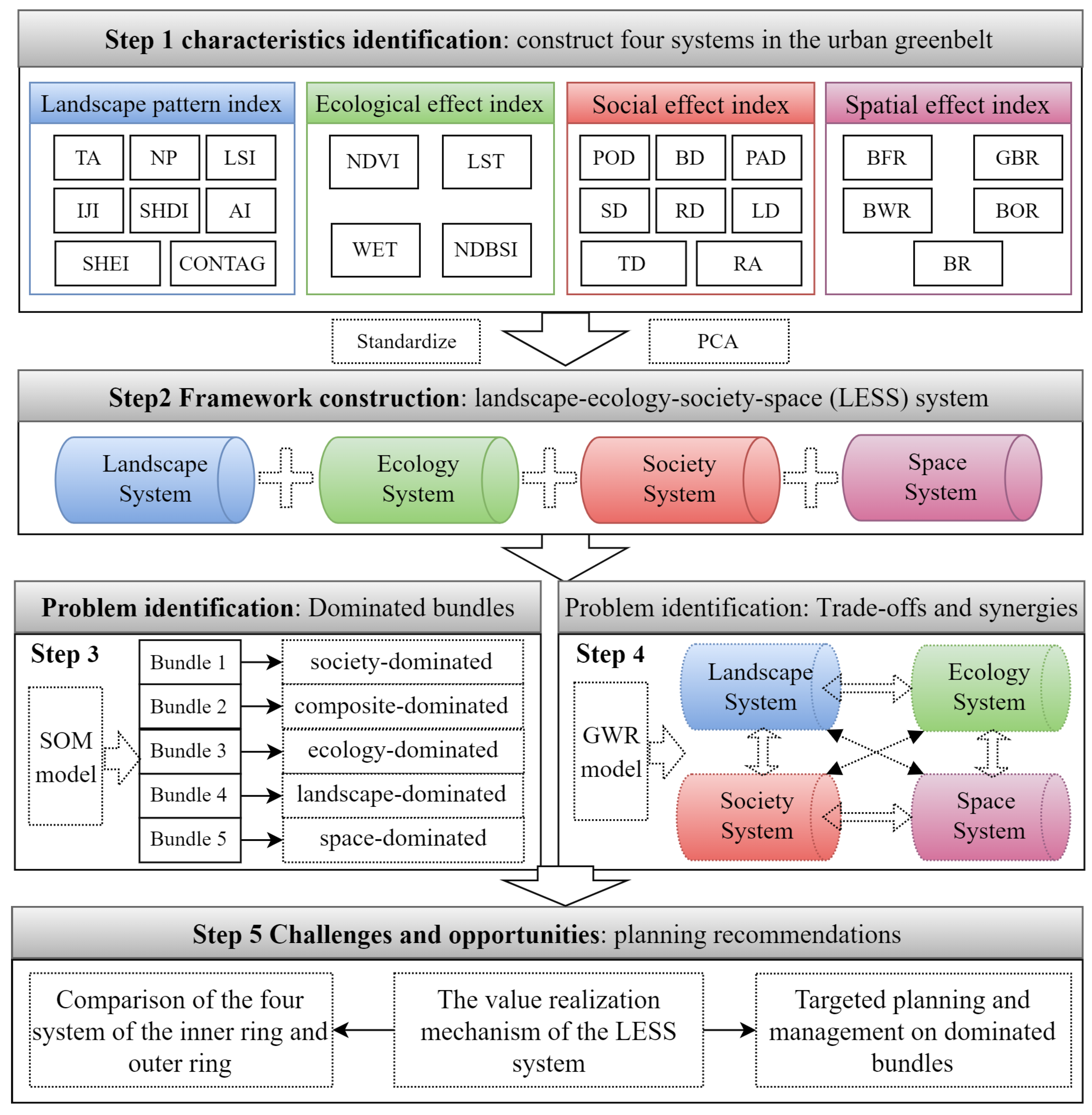
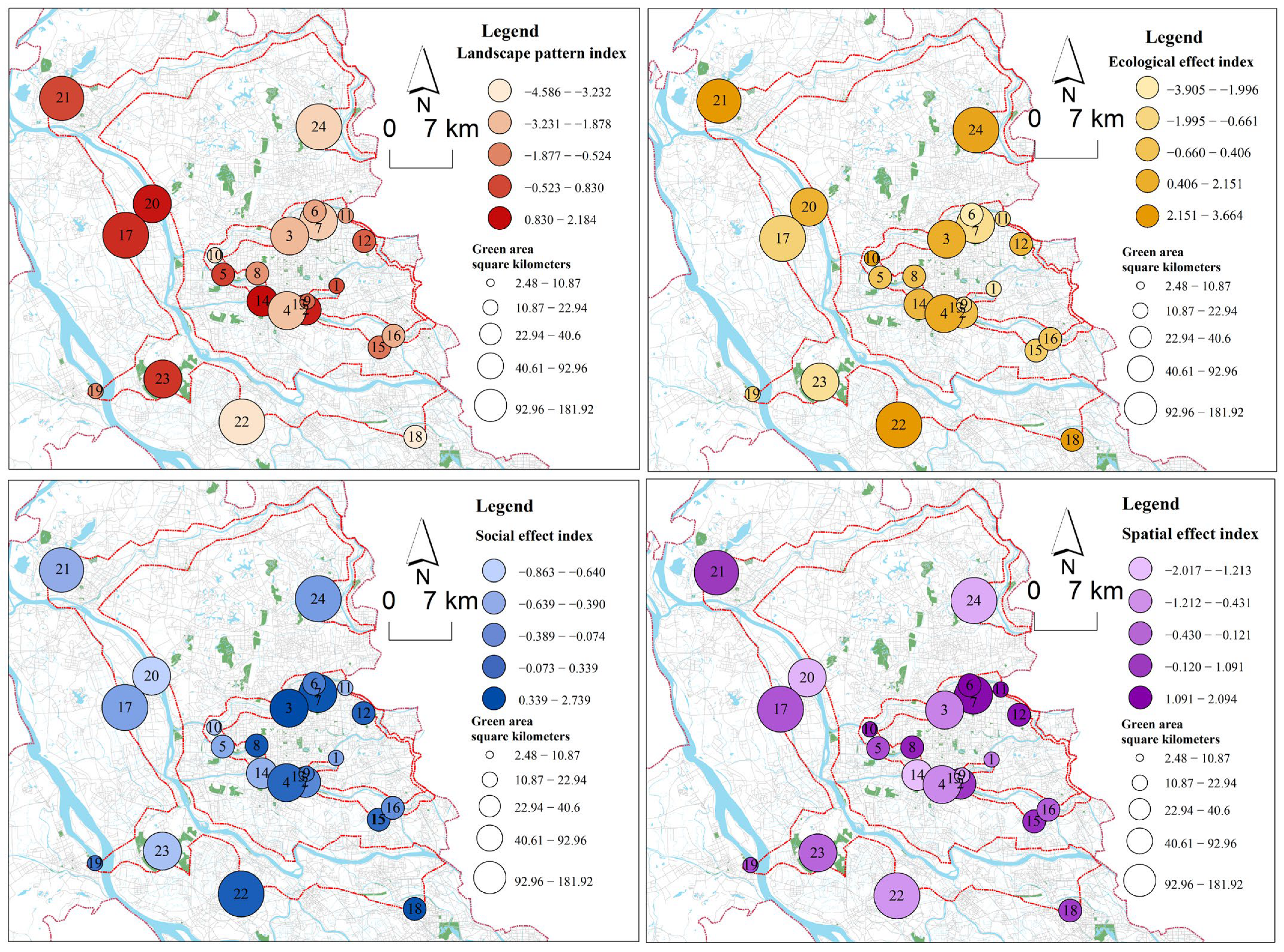
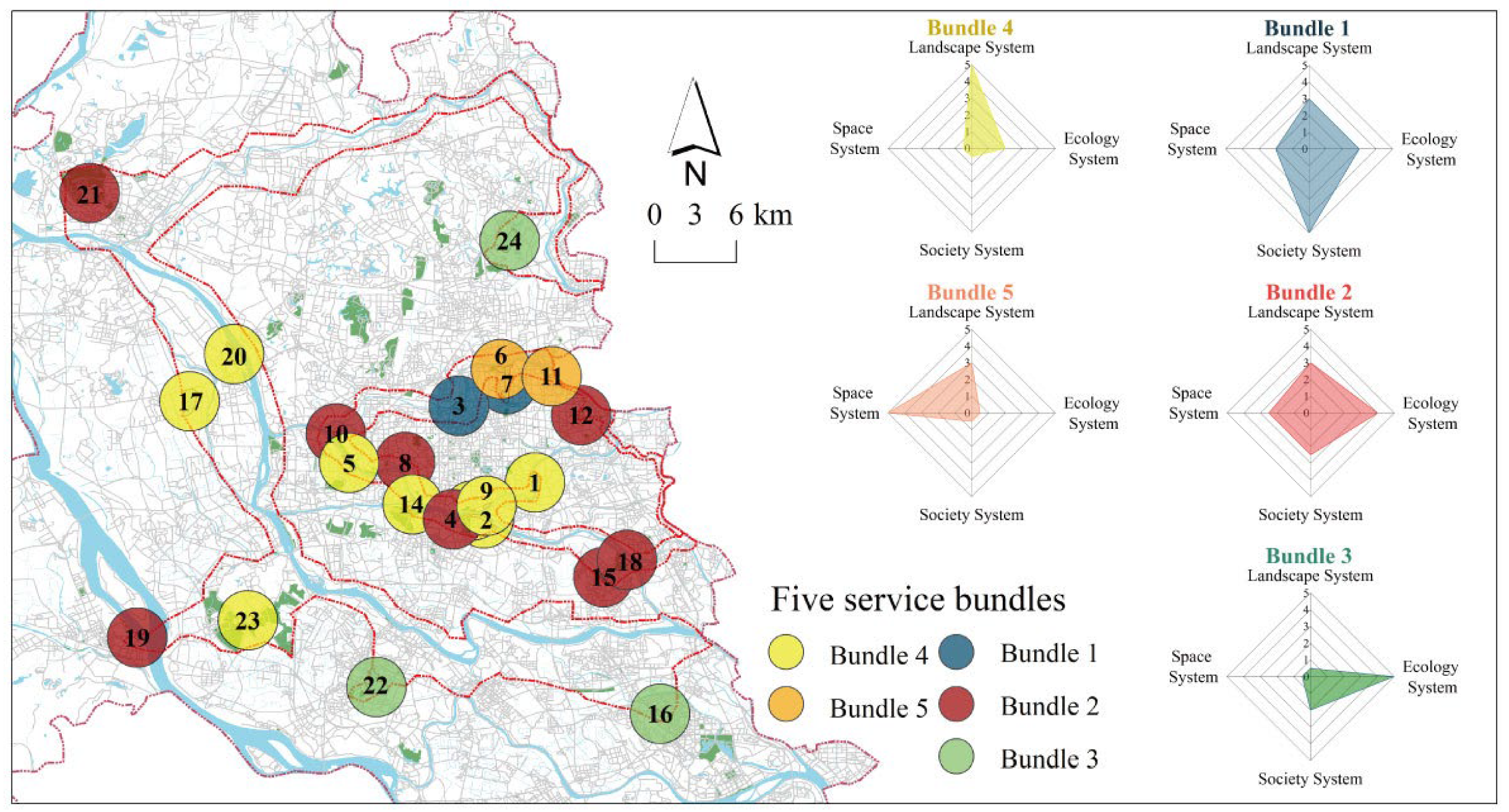
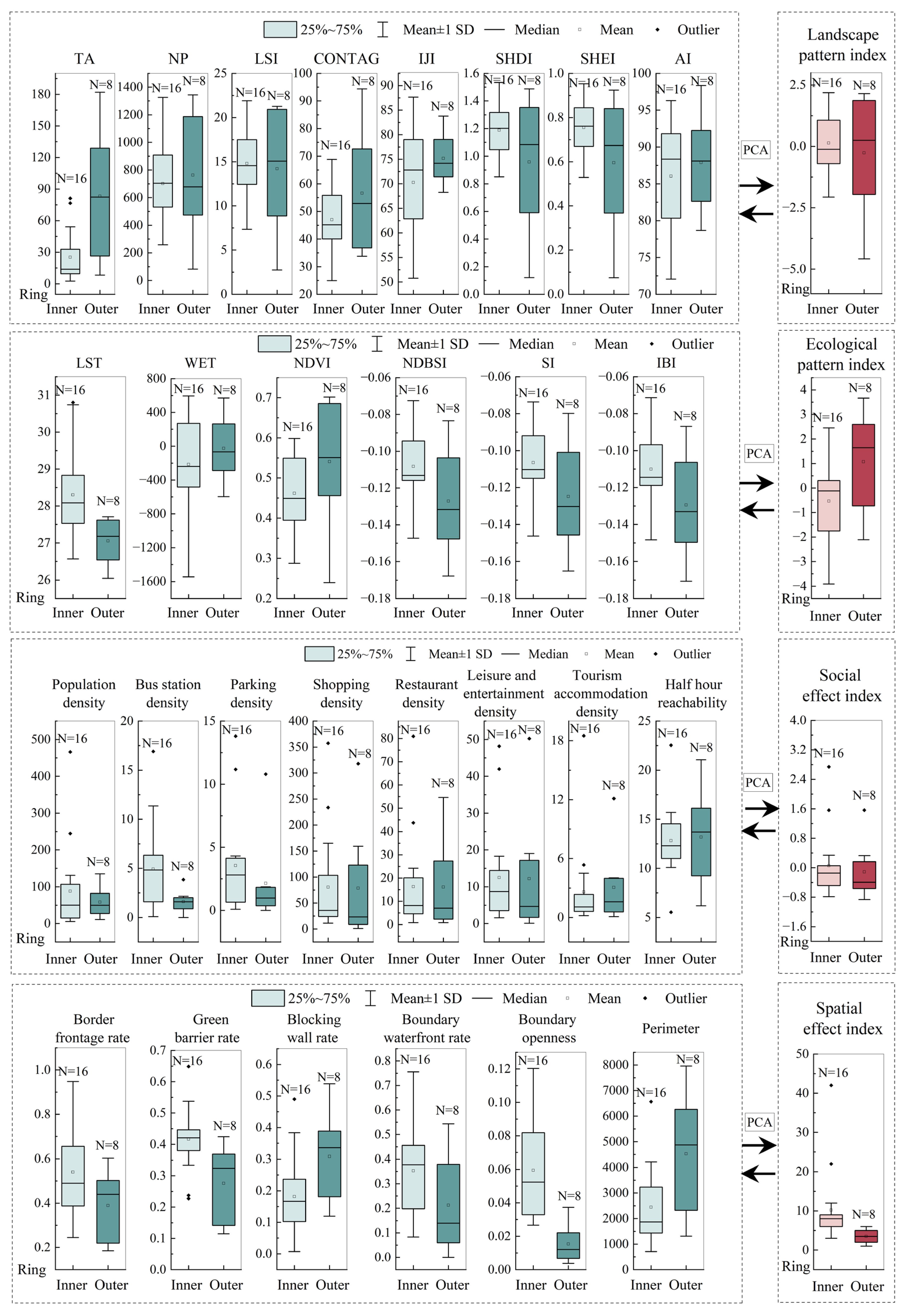
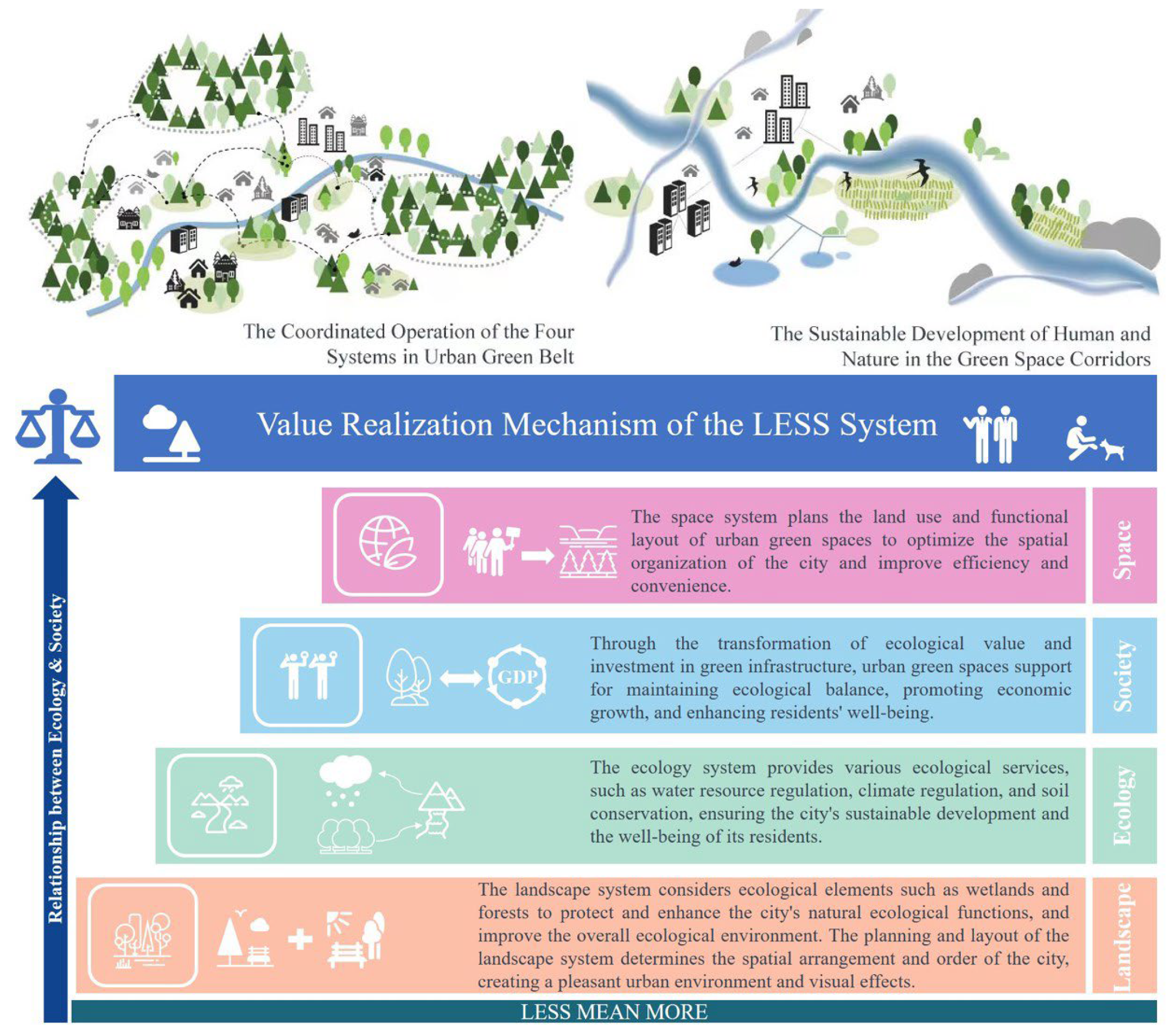
| Landscape Pattern Index | Ecological Effect Index | Social Effect Index | Spatial Effect Index | |||||
|---|---|---|---|---|---|---|---|---|
| Index | Weight | Index | Weight | Index | Weight | Index | Weight | |
| TA | 0.128 | NDVI | 0.390 | POD | 0.055 | BFR | 0.439 | |
| NP | 0.324 | BD | 0.129 | |||||
| LSI | 0.369 | WET | 0.408 | PAD | 0.151 | GBR | 0.315 | |
| CONTAG | −0.307 | SD | 0.141 | |||||
| IJI | 0.193 | LST | 0.393 | RD | 0.153 | BWR | 0.214 | |
| SHDI | 0.287 | LD | 0.151 | |||||
| SHEI | 0.281 | NDBSI | SI | −0.514 | TD | 0.142 | BR | −0.292 |
| AI | −0.274 | IBI | −0.513 | RA | 0.078 | BOR | 0.323 | |
| Number | Park | Landscape System—Ecology System | Landscape System—Society System | Landscape System—Space System | Ecology System—Society System | Ecology System—Space System | Society System—Space System |
|---|---|---|---|---|---|---|---|
| P1 | Half Moon Island Wetland Park | −0.198 | −0.238 | 0.221 | 0.086 | 0.064 | −0.188 |
| P2 | Riverside Wetland Park Children’s Park | −0.280 | −0.598 | −1.153 | 0.088 | 0.015 | −0.164 |
| P3 | Chancheng Zhongshan Park | −0.142 | −1.172 | −0.254 | 0.052 | 0.072 | −0.220 |
| P4 | Foshan New Town Riverside Wetland Park | −0.278 | −2.675 | 1.632 | 0.083 | 0.081 | −0.161 |
| P5 | Green Island Lake Wetland Park | −0.263 | −1.692 | −0.504 | 0.050 | 0.032 | −0.166 |
| P6 | Nanhai National Fitness Sports Park | −0.135 | −0.410 | −0.336 | 0.048 | 0.060 | −0.249 |
| P7 | Qiandeng Lake Park | −0.134 | −0.659 | −1.299 | 0.053 | 0.004 | −0.241 |
| P8 | Shiwan Park | −0.218 | −0.462 | −0.455 | 0.059 | 0.053 | −0.181 |
| P9 | Shiwan Wetland Park | −0.248 | −2.524 | −0.784 | 0.084 | −0.020 | −0.171 |
| P10 | Wang Bengang Forest Park | −0.230 | −0.610 | −0.410 | 0.039 | 0.063 | −0.175 |
| P11 | Wuyakou Park | −0.131 | −0.448 | −0.293 | 0.058 | 0.070 | −0.251 |
| P12 | Ying Yue Lake Park | −0.112 | −0.697 | −0.474 | 0.075 | 0.055 | −0.230 |
| P13 | Fishing Village Cultural Park | −0.260 | −0.402 | −0.318 | 0.083 | 0.059 | −0.167 |
| P14 | Zhouweiwei Park | −0.273 | −0.557 | −0.606 | 0.072 | 0.044 | −0.162 |
| P15 | Beijiao Park | −0.549 | −0.584 | −0.773 | 0.123 | 0.033 | −0.144 |
| P16 | Junlan Riverside Park | −0.539 | −0.661 | −0.493 | 0.124 | 0.053 | −0.152 |
| P17 | Hanlin Lake Park | −0.577 | −1.147 | −0.218 | 0.005 | 0.076 | −0.105 |
| P18 | Fengling Park | −1.133 | −0.601 | −0.743 | 0.179 | 0.035 | −0.063 |
| P19 | Linggui Park | −0.703 | −2.808 | −0.860 | 0.065 | −0.025 | 0.010 |
| P20 | Nanhai Wetland Park | −0.349 | −0.629 | −0.598 | −0.001 | 0.044 | −0.158 |
| P21 | Sanshan Forest Park | −0.479 | −0.677 | −0.514 | −0.070 | 0.051 | 0.176 |
| P22 | Tianhu Forest Park | −0.631 | −0.381 | −0.253 | 0.116 | 0.066 | −0.060 |
| P23 | Fishermen’s Village Yueyun Park | −0.653 | −0.654 | −0.473 | 0.078 | 0.055 | −0.052 |
| P24 | Zhanqifeng Park | −0.160 | −1.311 | −0.817 | 0.008 | 0.008 | −0.334 |
Disclaimer/Publisher’s Note: The statements, opinions and data contained in all publications are solely those of the individual author(s) and contributor(s) and not of MDPI and/or the editor(s). MDPI and/or the editor(s) disclaim responsibility for any injury to people or property resulting from any ideas, methods, instructions or products referred to in the content. |
© 2023 by the authors. Licensee MDPI, Basel, Switzerland. This article is an open access article distributed under the terms and conditions of the Creative Commons Attribution (CC BY) license (https://creativecommons.org/licenses/by/4.0/).
Share and Cite
Chen, L.; Ma, Y. A Framework for Assessing Trade-Offs and Synergies in Green Space System Services Based on Ecosystem Services Bundles. Forests 2023, 14, 1614. https://doi.org/10.3390/f14081614
Chen L, Ma Y. A Framework for Assessing Trade-Offs and Synergies in Green Space System Services Based on Ecosystem Services Bundles. Forests. 2023; 14(8):1614. https://doi.org/10.3390/f14081614
Chicago/Turabian StyleChen, Lihua, and Yuan Ma. 2023. "A Framework for Assessing Trade-Offs and Synergies in Green Space System Services Based on Ecosystem Services Bundles" Forests 14, no. 8: 1614. https://doi.org/10.3390/f14081614
APA StyleChen, L., & Ma, Y. (2023). A Framework for Assessing Trade-Offs and Synergies in Green Space System Services Based on Ecosystem Services Bundles. Forests, 14(8), 1614. https://doi.org/10.3390/f14081614





